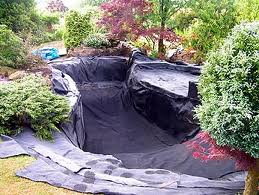





Before constructing a koi pool, it is worth learning a little of the background of these remarkable fish and of their behaviour. Although the koi carp is a distant relative of the goldfish, its way of life is almost completely different. While the goldfish will swim serenely beneath waterlily pads, koi carp will thrash about and create havoc. They also have special environmental and nutritional requirements, which must be met if they are to prosper. Remember that they are highly sophisticated in-bred fish and, as such, are not as easy to satisfy as their more lowly cousins.
 The environmental requirements of koi have a considerable bearing upon the pool construction. A koi pond must have filtered and constantly recirculated water with a stable pH, very low ammonia, nitrite and nitrate levels, and oxygen close to saturation point. To achieve this, the pool must have a suitable filtration system, which should function continuously. For a koi pool to be really successful, it should also be at least 1.5m (5ft) deep and have a capacity of at least 9,000 litres (2,000 gallons).
The environmental requirements of koi have a considerable bearing upon the pool construction. A koi pond must have filtered and constantly recirculated water with a stable pH, very low ammonia, nitrite and nitrate levels, and oxygen close to saturation point. To achieve this, the pool must have a suitable filtration system, which should function continuously. For a koi pool to be really successful, it should also be at least 1.5m (5ft) deep and have a capacity of at least 9,000 litres (2,000 gallons).
Traditional garden pools do not make good koi ponds, so a specialized structure is necessary. This can take the form of a raised pool, built from concrete blocks with an outer skin of facing bricks and the inside coated with a waterproof render. Alternatively, a large plastic container, as used for water storage, can be set within a brick surround. This will not only provide a more pleasing appearance, but can also add stability. For guaranteed strength, opt for a double-skinned wall, which should he tied together and built on a proper foundation.
When constructing the pool, take into account the filtration requirements. Although, in principle, these are the same as for a garden pool, they will be on a much larger scale. Experienced koi keepers would expect the biological area of the filter to be at least a third of the pond area and, preferably, a half. The system will also be more efficient if this part of the filter is constructed as one chamber, rather than being divided into smaller sections. Some modern filters use less conventional designs and incorporate high-tech media with very different flow rates to the normal arrangement. If you decide to use one of these, it is essential to follow the manufacturer’s instructions to the letter.
Most koi owners favour an in-ground, gravity fed filter. This is built on the same level as the pond and has large input pipes from bottom drains in the pond, the pump being situated towards the end of the system. Many pool owners contrive to construct their own systems because it seems to be more economical. However, if you are taking your first steps into koi culture, this would be folly, for without actual experience, it would be difficult to achieve the correct setup, even with the guidance of a koi expert. A manufactured system of the correct size, fully integrated into the construction programme from the beginning, will be the most satisfactory, and almost certainly the most cost-effective, way forward.
Only useful for larger excavations if sandwiched between two layers of soil; low burst resistance; difficult to install, has no elasticity; perishes easily if exposed to sunlight; not easily repaired.
Flexible and easily installed; often available in a range of colours; economical to buy; said to have a useful life of 10-15 years; can be repaired.
Flexible and easily installed; economical to buy; has a long life; can be repaired.
Flexible and very durable with a pleasing unobtrusive finish; expensive, but easily repaired.
Considerable resistance to sunlight degradation; little choice of shape; often poor accommodation for plants.
Cheap and resistant to sunlight degradation; more difficult to install than most other pre-formed pools; little choice of shape; often poor accommodation for plants.
Resistant to sunlight degradation; the most expensive preformed pool, but very durable; little choice of shape; often poor accommodation for plants.
Versatile; can be used to create a wide variety of water features; needs skilled installation; often difficult to repair successfully, but if properly installed, very durable.
Difficult to install; demands skill to maintain successfully.
Excellent for natural ponds, especially large water features; demands skilled installation; self-healing if punctured.
Copyright © www.100flowers.win Botanic Garden All Rights Reserved